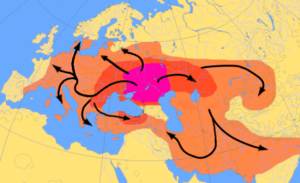Kurgan hypothesis - Simple English Wikipedia, the free encyclopedia

The Kurgan model of Indo-European origins is about both the people and their Proto-Indo-European language.
It uses both archaeology and linguistics to show the history of their culture at different stages of the Indo-European expansion.
The Kurgan model is the most widely accepted theory on the origins of Indo-European.
- "The Kurgan solution is attractive and has been accepted by many archaeologists and linguists, in part or total. It is the solution one encounters in the Encyclopædia Britannica and the Grand Dictionnaire Encyclopédique Larousse".[1]
- "The single most popular proposal is the Pontic steppes".[2]
Background
[change | change source]When it was first suggested in 1956, Marija Gimbutas's answer to the question of Indo-European origins was a pioneering interdisciplinary synthesis of archaeology and linguistics. From the nineties on, new archaeological evidence from Northern European prehistoric cultures was put forward on the influence and expansion of Kurgan cultures.[3]
Related pages
[change | change source]References
[change | change source]- ↑ Mallory J.P. 1991. In search of the Indo-Europeans: language, archaeology, and myth. London: Thames & Hudson, 185. ISBN 0-500-27616-1
- ↑ Strazny, Philipp (ed) 2000. Dictionary of historical and comparative linguistics. Routledge, 163. ISBN 978-1-57958-218-0
- ↑ Dexter, Miriam Robbins & Jones-Bley, Karlene eds. 1997. The Kurgan culture and the Indo-europeanization of Europe: selected articles from 1952 to 1993. Washington, DC: Institute for the Study of Man. ISBN 0-941694-56-9


 French
French Deutsch
Deutsch